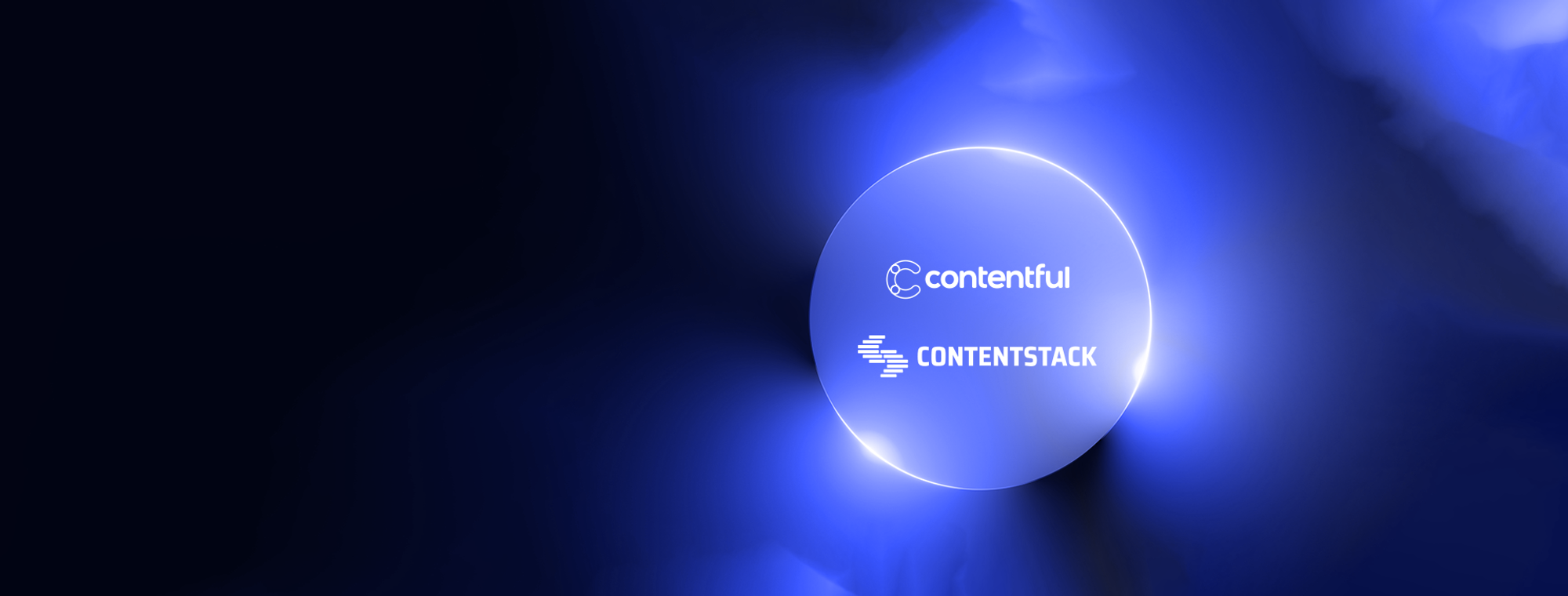Contentful vs. Contentstack
Businesses dealing with digital content often encounter challenges managing updates, ensuring scalability, and maintaining consistent messaging across channels. Many have turned to headless Content Management Systems (CMS) as a solution to streamline content creation and delivery. Yet, with various options like Contentful and Contentstack available, choosing the right one for specific business needs can be a complex task.
When picking a headless CMS, it’s crucial to consider factors like scalability, API compatibility, structured content organization, multilingual capabilities, and efficient collaboration in content management.
Before we dive in, let’s quickly dissect what we’re talking about when we say “headless CMS.”
What is headless CMS?
A headless CMS (content management system) is a software platform that allows content creators to manage and organize digital content (such as text, images, and videos) separately from how it is displayed on a website or application. Unlike traditional CMS, a headless CMS does not dictate how content is presented, providing more flexibility for developers to use various frontend technologies.
This separation of content from presentation enables content to be delivered to multiple channels, such as websites, mobile apps, and IoT devices, providing a consistent user experience across different platforms.
What is a traditional CMS?
A traditional CMS is a digital system or software that facilitates creating, managing, and distributing various forms of content, such as text, images, videos, and other multimedia elements. It provides tools and features for content creators to organize, edit, and publish content to different channels, like websites, mobile apps, and social media platforms.
Additionally, traditional CMS platforms often offer collaboration, workflow management, and analytics capabilities to enhance the content creation and distribution process. They serve as central hubs for businesses and individuals to manage and share information with their target audience effectively.
How is a headless CMS different from a traditional CMS?
A headless CMS focuses primarily on content creation, management, and organization, allowing for the separation of content from its presentation. This enables developers to use any frontend technology to display the content on various platforms. It provides a flexible foundation for delivering content to websites, mobile apps, and other digital touchpoints.
A traditional CMS, on the other hand, encompasses a broader set of tools and features beyond content management. It includes content creation, collaboration, distribution, and analytics capabilities and often provides a holistic solution for managing all aspects of content across different channels and platforms.
Content stored in a headless CMS is transmitted through APIs to be showcased on various devices. This contrasts with conventional CMS systems, which have predefined rules on where content can be presented.
Contentful
Contentful is a cutting-edge headless CMS designed to revolutionize how you create, manage, and distribute digital content. Contentful’s “composable” approach means you can structure and manage content independently of how it will be displayed on various platforms. Contentful acts as a central content platform and system of reference.
It offers a dynamic, API-driven system that allows you to deliver content seamlessly to websites, mobile apps, IoT devices, and other digital touchpoints. Contentful’s intuitive interface, robust localization capabilities, and extensive integration options make it a flexible and scalable CMS. Contentful’s cloud-based architecture ensures high availability and scalability, providing a reliable foundation for content management.
Contentstack
Contentstack is a modern headless CMS that helps you create, manage, and deliver digital content across various platforms and channels. With Contentstack’s headless architecture, you can use any front-end technology, which gives you the flexibility and creative freedom to design user experiences.
Contentstack offers a comprehensive solution for businesses seeking a dynamic and agile CMS with features like content modeling, workflow management, and localization support. Contentstack’s cloud-based infrastructure ensures scalability and high performance, providing a robust foundation for content management.
The differences
While Contentful and Contentstack are both headless CMS platforms, they offer different benefits. Below, you’ll find some of the biggest differences between the two. Make sure to check the FAQs section for both platforms.
Architecture and approach
Contentful: Contentful offers unparalleled flexibility, designed to adapt seamlessly to business scenarios of any size and complexity. It offers a user-friendly interface and is known for its developer-friendly approach.
Contentstack: Contentstack provides a highly customizable platform with an extensive set of features, making it suitable for businesses with complex content management needs.
Content modeling and structuring
Contentful: Contentful adopts a user-friendly approach to content modeling, underscored by its Visual Modeler which simplifies the creation of complex content structures. This is particularly advantageous for organizations with multifaceted content ecosystems, as Contentful’s extensive validation options—for instance, restricting types and numbers of entries in rich text fields—facilitate stringent content governance.
Contentstack: Contentstack offers advanced content modeling features, such as global fields that allow for the reuse of variables, and Singleton entries for defining elements like a company address just once. These capabilities are best leveraged within a single stack, making Contentstack’s approach potentially neater for straightforward site structures, though the same Singleton functionality in Contentful is generally viewed as an anti-pattern.
Localization and internationalization
Contentful: Contentful’s field-level localization caters to businesses with complex internationalization needs, providing a broad range of localization options and the ability to easily organize translations for each entry. The platform’s language-based permissions are customizable for each rule, which is particularly useful for detailed field-level localization.
Additionally, Contentful’s AI translation generator offers a straightforward option for automated translations, streamlining the localization process for a wide variety of use cases.
Contentstack: Contentstack excels in entry-level localization, making it a more straightforward choice for cases where detailed language governance isn’t required. This approach allows for quick and efficient management of localized content, with the flexibility to define non-localizable fields.
While the platform provides a solid number of translation providers and supports global locale rules for roles, it also maintains a simpler user experience by not requiring users to navigate as many translations within the interface.
Workflow and collaboration
Contentful: Contentful provides a streamlined workflow feature set, accommodating businesses with more direct content approval processes. For organizations that require custom workflow configurations, Contentful offers the flexibility to adapt its basic workflows to fit more complex needs. Its Merge application enhances the user experience by presenting a clear interface for version comparison.
Contentful’s approach, which includes a Pending tasks panel, helps centralize task management and simplifies tracking of open tasks without overwhelming the core CMS functionality.
Contentstack: Contentstack offers a robust workflow management system that is particularly adept at handling the demands of larger organizations with multi-tiered content approval hierarchies. It centralizes task management, which can streamline operations for teams dealing with high volumes of content.
Additionally, Contentstack affords capabilities like asset version management and the direct restoration or deletion of content types and records, giving teams more autonomy over their content lifecycle compared to the archiving-first approach of Contentful.
Developer resources and documentation
Contentful: Contentful stands out with its thorough documentation and a suite of developer resources that streamline the integration and development process, enabling developers of all skill levels to quickly become productive. The platform’s Sync API is particularly noteworthy for its ability to support offline mobile applications through delta sync capabilities, ensuring only changed content is updated.
Contentstack: Contentstack matches Contentful in offering comprehensive documentation and resources, further augmented by its Automation Hub, which acts like a built-in Zapier to significantly expand CMS capabilities. The platform also distinguishes itself with frontend hosting options, adding convenience for developers managing full-stack projects.
While Contentstack’s CLI and extension capabilities are on par with Contentful, it provides additional features such as security audit logs, which are invaluable for monitoring and compliance.
Pricing and licensing
Contentful: With a pricing structure that caters to a range of business sizes, Contentful offers a clear entry point for smaller businesses through a free tier, scaling up with a usage-based model. Pricing tiers are primarily defined by the number of spaces, content types, and user roles, making it straightforward for businesses to align their usage with their budget.
The premium tiers of Contentful remain competitive, often matching the entry point of Contentstack’s custom packages. The pricing tiers are primarily defined by the size and number of spaces, chosen SLA levels, and selecting either shared or dedicated cloud infrastructure.
Contentstack: Contentstack, while not offering a free tier, structures its pricing around custom packages that start at a point equivalent to Contentful’s higher-tier offerings. This reflects Contentstack’s emphasis on delivering a richer feature set even in its most basic plans.
The focus on content types and users in its pricing model is particularly accommodating for businesses that require a more liberal content structure without the constraints of predefined pricing levels. The number of digital channels that content gets delivered to is factored into the pricing.
Integration ecosystem
Contentful: Contentful has a broad range of third-party integrations and a vibrant ecosystem, making connecting with various tools and services easy.
Contentstack: Contentstack offers extensive integrations, particularly with popular marketing and ecommerce platforms, making it well-suited for businesses with complex tech stacks. However, Contentstack has a swiss-army tool not available in Contentful – the Automation Hub, where integrations with external services can be quickly built in a no-code environment. Contentstack’s Automation Hub can quickly become pricey, as it is charged by script runs.
Pros
Contentful: Renowned for its flexibility and scalability, fitting for complex organizational needs. User-friendly and developer-friendly, with extensive documentation and developer resources. Advanced localization capabilities with customizable options for global reach. Extensive integration ecosystem facilitating a wide range of third-party services. Offers a free tier with usage-based pricing, allowing businesses to grow at their own pace.
Contentstack: Mature headless CMS offering a comprehensive set of out-of-the-box features.Advanced content modeling capabilities, ideal for intricate content structures. Strong multilingual support with entry-level localization. Robust workflow management tailored for complex content approval processes. Developer-centric environment with unique tools like the Automation Hub and frontend hosting.
Cons
Contentful: Content modeling may require additional effort as complexity increases.
Contentstack:Custom pricing models can be expensive for small to medium-sized businesses.
In short, Contentful is an excellent choice for organizations that need a CMS capable of scaling with their complexity. Its ability to support large-scale, multifaceted organizations, combined with its strong focus on developer support and a broad integration ecosystem, makes it a strong contender for businesses aiming for growth and global reach.
Contentstack stands out as a mature headless CMS provider, with a wealth of features ready to serve the intricate needs of advanced content management projects. Its robust content modeling and localization capabilities make it an ideal choice for businesses that have complex content strategies and require comprehensive workflow management from the outset.
When selecting a CMS, consider the scalability requirements and the desired feature depth. Contentful is suitable for organizations that need to scale flexibly, while Contentstack is the go-to for those seeking a fully-featured headless CMS with extensive capabilities for complex content operations.




